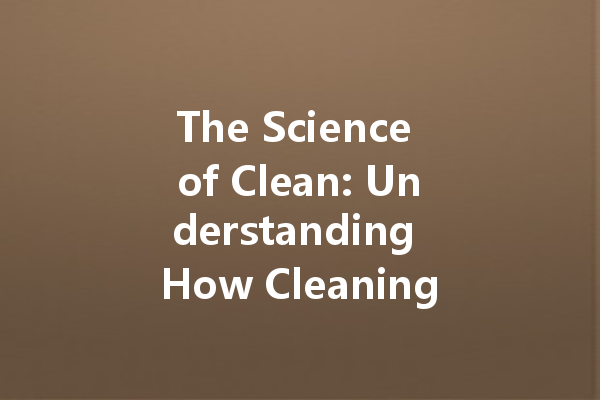Cleaning agents, commonly known as detergents or cleaners, play an essential role in maintaining hygiene and cleanliness in our homes, workplaces, and public spaces. They are crafted with specific chemical ingredients designed to tackle dirt, stains, and germs effectively. This article delves into the science behind these products, exploring how they function and their impact on health and the environment.
洗浄剤とは何か?
Cleaning agents are substances formulated to remove dirt, stains, and unwanted matter from various surfaces. They can come in many forms, including liquids, powders, gels, and sprays. The effectiveness of a cleaning agent largely depends on its active ingredients, which can include surfactants, enzymes, solvents, and acids.
界面活性剤主要プレーヤー
Surfactants, or surface-active agents, are a primary component of most cleaning products. These molecules work by reducing the surface tension of water, which allows it to spread and penetrate more easily into surfaces. Surfactants have hydrophilic (water-attracting) and hydrophobic (water-repelling) parts. When applied to a surface, they surround and break down dirt and grease, allowing them to be washed away.
Enzymes: Biological Cleaners
Enzymes are another crucial ingredient found in some cleaning agents, particularly those designed for laundry or removing organic stains. These biological catalysts work by breaking down specific types of stains, like proteins, fats, and starches, into smaller, more manageable molecules. This enzymatic action can significantly enhance the cleaning efficiency, especially for tough stains.
The Role of pH in Cleaning
The pH level of a cleaning agent is also vital in determining its effectiveness. Most household cleaning products are either acidic or alkaline, each designed for specific cleaning tasks.
アルカリクリーナー
Alkaline cleaners, usually having a pH above 7, are highly effective in breaking down organic materials like grease and oils. They work by saponifying fats, turning them into soap that can easily be rinsed away. Common examples of alkaline cleaners include liquid soaps and oven cleaners.
酸性クリーナー
On the other hand, acidic cleaners, with a pH below 7, are effective in removing mineral deposits, rust, and hard water stains. They react chemically with the deposits, breaking them down and allowing them to be easily wiped away. Products like toilet bowl cleaners and descalers often fall into this category.
The Impact of Fragrance
Many cleaning agents contain fragrances to provide a pleasant scent. While these fragrances enhance user experience, they can also have implications for health and the environment.
Allergic Reactions and Sensitivities
Some fragrances may contain allergens, leading to respiratory issues or skin irritations in sensitive individuals. It is essential for consumers to be aware of their sensitivities and choose products accordingly. Labels often indicate if a product is fragrance-free or formulated for sensitive skin.

環境への配慮
The production and disposal of cleaning agents can contribute to environmental pollution. Many synthetic fragrances are derived from petrochemicals, which raise concerns about sustainability. Manufacturers are increasingly developing eco-friendly alternatives that use natural scents derived from essential oils or plant extracts.
Effectiveness in Disinfection
Understanding how cleaning agents work goes beyond mere cleaning; it encompasses the need for disinfection, especially in the context of health safety.
How Disinfectants Work
Disinfectants contain specific ingredients designed to kill or deactivate pathogens, including bacteria, viruses, and fungi. The effectiveness of a disinfectant is influenced by its active ingredients, contact time, and surface type being treated.
The Importance of Proper Use
To achieve effective disinfection, it’s crucial to follow the manufacturer’s instructions regarding application methods, contact time, and dilution requirements. Skipping these steps can lead to inadequate disinfection, potentially resulting in the survival of harmful pathogens.
洗浄剤の未来
As we move towards more eco-conscious living, the future of cleaning agents looks promising with innovations focused on safety and sustainability.
生分解性成分
With growing concerns over plastic waste and pollution, many manufacturers are turning to biodegradable ingredients that break down naturally in the environment. These products are not only effective but also minimize ecological impact.
スマート・クリーニング・ソリューション
Advancements in technology are paving the way for smart cleaning solutions that incorporate artificial intelligence and IoT (Internet of Things) functionalities. These innovations can lead to more efficient cleaning schedules, precise formulation adjustments, and better resource management.
Conclusion: Cleaning Agents and Their Importance
In summary, understanding the science behind cleaning agents is crucial not only for effective cleaning but also for making informed choices that protect our health and the environment. By considering the types of ingredients used, their mechanisms of action, and potential impacts, consumers can select cleaning products that align with their values and needs. As technology continues to evolve, we can expect even more advancements in the way cleaning agents perform to keep our spaces safe and hygienic.
